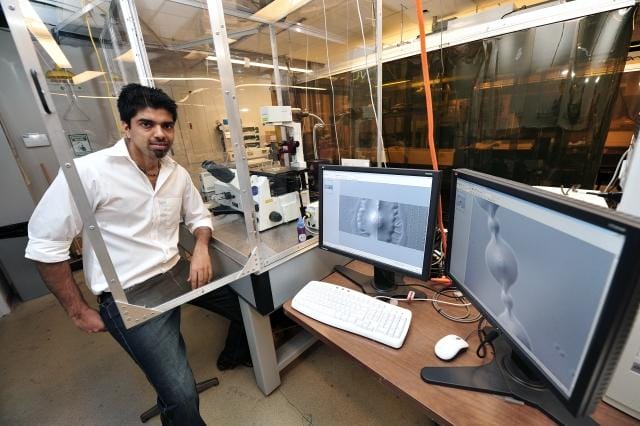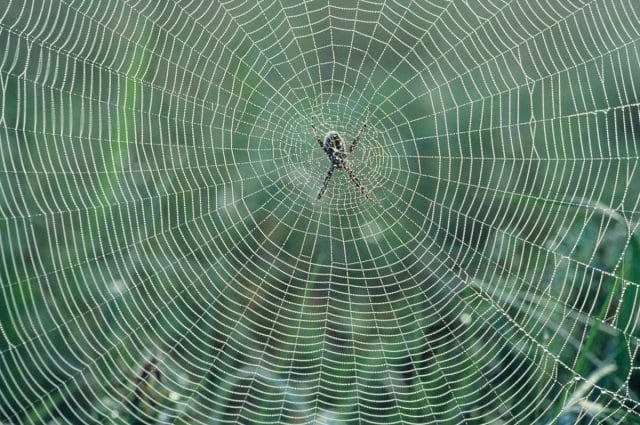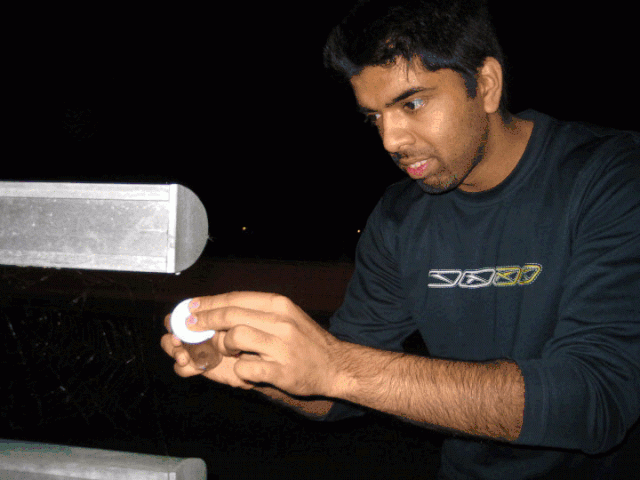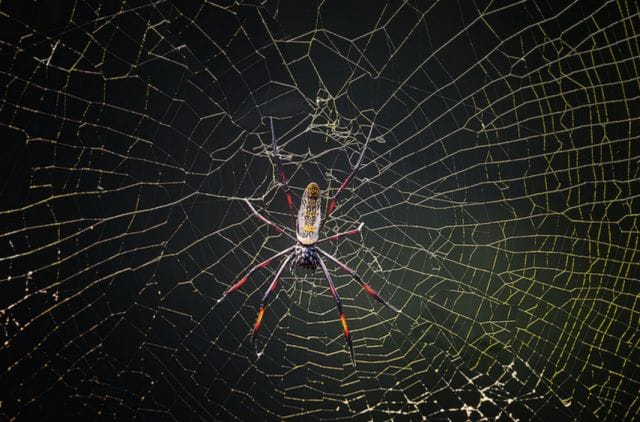
Via Vasav Sahni
![]()
It was toward the tail end of his senior year at the Indian Institute of Technology in Delhi that Vasav Sahni fell in love with polymer science. “I was working on a project where I was using electrospinning to create nano-filters,” he recalls, “and I thought, ‘Yeah, this is for me.’”
Polymers, for those not in the know, are large molecules that are made up of many subunits. They range in scope from synthetic plastics to proteins, and possess unique defining qualities — viscoelasticity, toughness, durability — that can be applied in a variety of ways to consumer products. A harmony of chemistry, physics, and engineering, polymer science was a perfect marriage of Sahni’s interests, and he was smitten.
Upon graduating, the young scientist applied to the University of Akron, Ohio — the “best polymer science institute in the world” — and was accepted as a PhD candidate.
Here, in the depths of an engineering lab, his life took a wild turn:
“During my first year, I was given the freedom to explore any polymer-related area that interested me. I was reading about a lot of different things, trying to figure out what to do, and I came across spider silk, which is a polymer.”
Though copiously studied by biologists, spider silk was relatively unexplored in the polymer field at the time. It was well-established that spider webs contained 6 to 7 unique types of silk, but the specific properties of these silks hadn’t been scientifically categorized. Sahni realized that, while the silk of silkworms had been commoditized for thousands of years, the “adhesive capabilities” of spider silk hadn’t yet been capitalized.
What other polymer scientists had disregarded, Sahni saw as a golden opportunity to innovate.

Sahni in his old lab; via WKSU
The idea of exploring the adhesive properties of spider silks was equally foreign to his academic advisor. “It was a learning experience for both of us,” says Sahni, “because I was one of the first students in our department to work with spiders.” The team had to work in a laboratory that mimicked the environment of the spiders, complete with “twigs, brush, and proper humidity;” they also collaborated extensively with evolutionary biologists, developmental biologists, and physicists to be able to properly cultivate and study the silk.
But first, Sahni had to catch the spiders — and like 30% of Americans, he was afraid of them.
“I was scared…I don’t get along with anything non-human,” jokes Sahni. “There was a certain bridge we would go under at night — they like to be around humid water bodies, because the silk absorbs more water there, and when they recycle their webs the next day, they get their daily water intake.”
Particularly, Sahni was on the hunt for typical garden spiders, which produce “orb webs.” These webs, which he describes as begin shaped like wheels, are mainly composed of two types of silk, each with its own property and role: the ‘spokes’ are non-sticky and strong, and the spirals are sticky:

One of the biologists in Sahni’s group had previously studied spider silk, but only a very particular variety — the type that people often say is “stronger than steel” ounce for ounce — the adhesive properties were still largely unknown. “At the time, most research on spider webs was focused on the strong properties of silk, with the goal of making durable, lightweight synthetic materials” says Sahni, who had a different focus in mind:
“I wanted to look at the more adhesive silk. The main function of the web is to capture — to stick. So, we wanted to figure out things like why it sticks, how it maintains its stickiness in humidity, and how it sticks to insects. (Many insects are designed specifically not to stick to things, but these webs still capture them; by understanding why, we could see how to make adhesives that would stick to even stuff that was meant not to stick.)”
The spider’s inclination to create silk with two distinct properties could be considered a case of “intelligent” design. “We were intrigued by how cleverly spiders use silk to create a beautifully multifaceted adhesive and how they do so with very little glue,” writes Sahni’s old research partner and academic advisor, Ali Dhinojwala. “It teaches us how to take something minimal and make the most of it — how to design an attachment to hold things together in unique ways.”
What these spiders do, adds Sahni, is not unlike what his favorite superhero does. “When Spiderman jumps from one building to another, he throws a thread that sticks to a building and then he jumps,” he says. “The thread has to be very strong and also equally sticky — sticky enough to support him.”

Sahni capturing an orb spider
By the end of his PhD four years later, Sahni’s research had caught the attention of 3M, the massive manufacturer of adhesives.
Biomimicry, or using “nature’s time-tested patterns” to create products, has long interested the company. Specifically, they’ve studied geckos, which have microscopic hairs in their feet that allow them to hold up to 1,000 their weight — but they’ve never been able to use these studies to influence products.
“It’s very popular in the adhesive world to try to mimic the properties of geckos,” says Sahni. “But when you’re making something for a company, you have to make sure it’s cost effective and can be made in large quantities; most of the stuff that has been done to date is neither of those two.”
Sahni, who aims to create one of the world’s first biomimicry-based adhesives (that are also cheap and can be replicated), says that it hopefully won’t be too long before his team accomplishes its goal.
Right now, he’s working on developing an adhesive strong enough to “hold an LCD television to the wall without mounting it.” He’s also enlisted his spider web research to improve the inherent properties of bandages:
“We want to create a bandage that sticks really well to skin, but that also can be easily removed without pain. I have a very hairy arm, and when I remove a bandage, half my hair is gone. We don’t want that; we want it to be comfortable and, at the same time, stay in place.”
For Sahni, the bandage is a “Goldilocks paradox:” it can’t be too sticky, but it can’t be too loose — it has to be just right. The result could have tremendous benefits for not only the general public, but specialized patients who need sensitive adhesives for things like catheters.

Via Steve Slater
Sahni attributes much of his accomplishments to the environment at 3M. “I have a lot of freedom,” he says, “they’ve always encouraged me to do what I want to do.”
Decades ago, the company integrated a philosophy: 15% of every worker’s day should be devoted to innovating and developing their own products (similar strategies were later integrated at Google and other tech companies). This freedom has ended up producing a series of very profitable breakthroughs for 3M: Scotchlite reflective sheeting, Micropore surgical tape, foam tape, decorative ribbon, face masks, and respirators among them.
The company also maintains a tech forum, where researchers and engineers from different teams can cross-communicate, share ideas, and brainstorm.
“You’re encouraged to try to do things out of your comfort zone — that’s how innovation has happened here,” says Sahni. “When you look at things from an outsider’s perspective, that’s when you ask the most simple but crucial question: why is this happening?”
Though Sahni doesn’t work directly with spiders anymore (there’s a strict no-animals policy on 3M’s campus), he still finds himself asking this question every day while trying to synthesize his findings into viable products. And once severely arachnophobic, every now and then, the 30-year-old scientist now considers the eight-legged creatures his friends.
“Sometimes, I’ll see them crawling through my apartment,” he says, forlornly. “I miss them.”
![]()
This post was written by Zachary Crockett. You can follow him on Twitter here.
To get occasional notifications when we write blog posts, please sign up for our email list.



